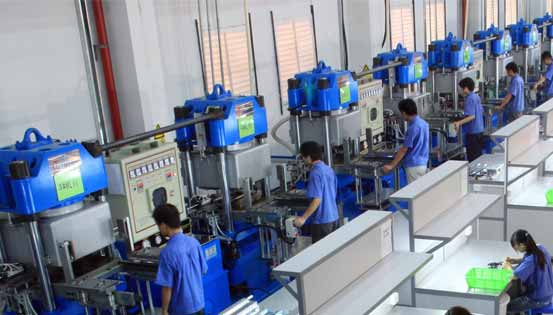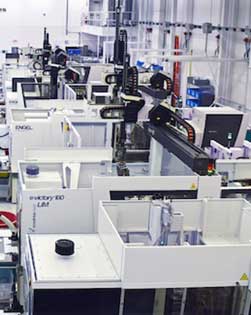We all know that rubber is available from two sources:
natural rubber and synthetic rubber. While the first one is produced using
latex drawn from rubber trees, the second one is artificially manufactured
using varied chemicals and synthetic substances. The most of the rubber
products that we use today is made from synthetic rubber as natural rubber
has certain mechanical, chemical and environmental resistance limitations.
So synthetic rubbers are formulated in a proper way to address these short
comings and are used to manufacture a wide range of
rubber molded products.
Rubber Molding Process and Formulation
There is no such thing as a particular rubber material. There is a custom
formulated product that is produced is such a way that the required rubber
product is manufactured as per the application need. Compared to other
materials like steel or plastic, rubber is a far more complex material and
many components are used which undergo chemical reaction during the
vulcanization process and finally used in the manufacturing cycle. Rubber
molding process is actually an art where the following challenges to be
considered.
- Flexible: Rubber can take up many shapes and deformations in its applications, which is not the case in other materials. Hence, rubber should be able to maintain its properties through a long period, infact, a lifetime of dynamic stressing. Rubber needs to be resilient enough to do its work even after being stretched, compressed or twisted hundreds of times.
- Chemical: Rubber is often required to withstand a wide number of chemicals. For instance, when rubber is used in motors or generators, it must be resistant to oils and gasoline. In some industrial applications, rubber needs to be resilient to harsh fluids like cleaning solvents, acids or alkalis. Without proper formulation, a rubber compound could actually gets crumbled or dissolved when faced with these corrosive substances.
- Environmental: Not only does rubber has to withstand corrosive chemicals, and remain flexible, but it also has to perform in temperature extremes. For example, a car with sealing O-Rings in its engine will be subjected to freezing temperatures in a very cold country and the same O-Rings have to withstand a normal temperature in a warm country.


Considering the above challenges, the formulation of the rubber molding
process starts. The first step in rubber formulation is to prepare the
requirements relating to conditions that the rubber will need to bear. The
conditions include the mechanical/dynamic requirements, besides the chemical
and environmental factors.
After thoroughly understanding all the requirements, a rubber formulation
chemist can actually come up with different components to create the
compound. It is difficult to come up with the exact formulation that will
optimize a given performance for an application. Before the actual product
is developed, the following factors are tested.
- Fluid immersion
- Temperature stressing
- Tensile strength
- Flex-cycling
- Elongation testing
- Ozone aging and
- Weathering
Rubber Molding This testing gives some idea of the product's performance. Once the tests are done, the acceptability of the rubber formulation is considered. Once the product is developed and tested, it is ready for manufacturing. Thus manufacturing of rubber molder products is not an easy task. That is why it is rightly been said that "rubber molding is an art rather than a science".
- Anti Vibration Mountings
- Automobile Rubber Products
- Calendered Rubber Products
- Extruded Rubber Products
- Medical Rubber Products
- Metal Bonded Components
- Rubber Adhesives & Sealants
- Rubber Ball
- Rubber Bands
- Rubber Beading
- Rubber Bearing
- Rubber Belt
- Rubber Buckets
- Rubber Bullets
- Rubber Cable
- Rubber Coating
- Rubber Duct
- Rubber Expansion Joints
- Rubber Flooring/Matting
- Rubber Footwear
- Rubber Gloves
- Rubber Injection Parts
- Rubber Lining
- Rubber Magnets
- Rubber Molded Products
- Rubber Pads
- Rubber Rollers
- Rubber Stopper
- Rubber Suit
- Rubber Track
- Rubber Valve
- Rubber Balloon
- Rubber Stamps
- Rubber Fenders
- Acrylic Rubber (ACM)
- Butadiene Rubber (BR)
- Butyl Rubber (IIR)
- Chlorosulfonated Polyethylene(CSM)/ Hypalon
- Ethylene Propylene Diene Monomer
- Fluoroelastomers (FKM)/Viton
- Isoprene Rubber (IR)
- Nitrile Rubber (NBR)
- Perfluoroelastomer (FFKM)
- Polychloroprene (CR)/Neoprene
- Polysulfide Rubber (PSR)
- Silicone Rubber (SiR)
- Styrene Butadiene Rubber
How to Make a Custom Rubber Stamp?
Whenever designing a custom stamp for your company, never compromise on its quality because in the end it is the most...
Read MoreLatex and Silicone Rubber Tubing - A Comparison!
Many industries use rubber tubing for various purposes. In fact, various types of rubber tubing are used for different applications...
Read MoreSilicone vs Acrylic Adhesive- A Comparison
Silicon and acrylic adhesives are those rubber adhesives that are widely used in Polyimide tapes. In fact, the polyimide...
Read More

